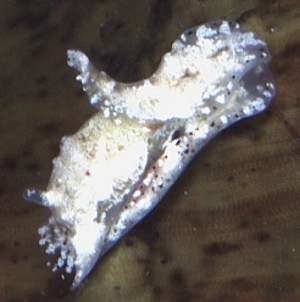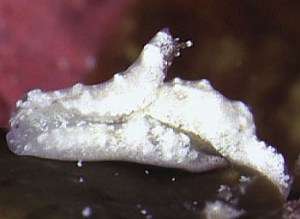

Aglajid sp. 1
Order: CEPHALASPIDEA
Superfamily: PHILINOIDEA
Family: Aglajidae
PHOTO
Kerama Is. near Okinawa in Japan. At 7m depth, on coral rubble (moved to algae for photograph), 3mm long. PHOTOS: Atsushi Ono.
See Atsushi Ono's message below.
Authorship detailsRudman, W.B., 2000 (April 25) Aglajid sp. 1 [In] Sea Slug Forum. Australian Museum, Sydney. Available from http://www.seaslugforum.net/find/aglajidsp1
Related messages
'Aglajid sp. 1' from Sulawesi
April 28, 2000
From: Lindsay Warren


Dear Bill
We think this specimen is a species of Philinopsis or Gastropteron. It was found by Doug Philpott at 4pm on 17 June 1999 at a depth of 9 m crawling along a patch of sand on a wall of Pulau Hoga [Tukang Besi
Archipelago, SE Sulawesi, Indonesia - Operation Wallacea]. Size: 4 mm.
The overall body colour is mottled creamy white with the posterior section being darker than the anterior and the two rounded tails white. Along the edge of the foot is a series of black spots. The texture is slightly bumpy rather than the more usual smooth texture of other species. The head is shield like with the posterior edge rising away from the body. Two black spots on either side of the front of the head might be eye spots. Photo: Lindsay Warren. Unfortunately not a very clear one!
Any ideas?
All the best
Lindsay Warren
100014.2112@compuserve.com
Warren, L., 2000 (Apr 28) 'Aglajid sp. 1' from Sulawesi. [Message in] Sea Slug Forum. Australian Museum, Sydney. Available from http://www.seaslugforum.net/find/2318Dear Lindsay,
This is another one of those coincidences which seem to occur quite often on the Forum. I am sure your animal is the same as the one in Atsushi Ono's message yesterday from Kerama Island in tropical Japan.
As I said in my reply to him I am pretty sure that this is an aglajid, but we would need to study its anatomy to be sure. It is interesting that you describe the head as 'shieldlike' for we in fact call that front section of the dorsal skin the head shield and the scientific name for the Order Cephalaspidea comes from two Greek words meaning head + shield. In a similar manner the Order Notaspidea are named for their back shield and the Sea Hares (Anaspidea) for their apparent lack of a shield.
Best wishes,
Bill Rudman.
Re: Aglajid sp. 1.
April 27, 2000
From: C. Carlson & P.J. Hoff

Bill,
Mr. Ono's aglajid seems to be a fairly common form that has generally escaped notice because of it's small size and color. Most of the forms we have found have various degrees of brown spotting on a tan
background. Two specimens in Palau were a fairly dark brown with tan margins. We have not seen one with thin crossing stripes. The average size of 21 measured specimens was just under 3mm.
c44 4.0mm; Guam, Bile Bay, reef flat; 25 March 1972
c45 2.0mm; Guam, Bile Bay, river channel; 3 January 1988.
c45_2 size? shell, ventral view; Guam, Bile Bay; July, 1972
Clay & Patty Jo
clay.carlson@kuentos.guam.net


Dear Clay & Patty Jo,
From your records and those of Atsushi Ono and Lindsay Warren it seems this is not uncommon. I have kept the other two? species, Atsushi sent photos of [aglajid sp 2, aglajid sp 3] separate at present.
Best wishes,
Bill Rudman.
Aglajid from Kerama Id, Japan
April 26, 2000
From: Atsushi Ono


Dear Bill
Thank you for ID of Hallaxa cryptica.
I found this cephalaspid species at Kerama Is. near Okinawa in Japan. It similar to Philinopsis, but I think it is a Philine species. The upper one is all white in color, the lower is a bit milky? and has black dots on the side of its foot and front side of head-shield. I think they are the same species...
They were found at 7m depth, on coral rubble (I moved them to an algae to photograph, because it is difficult to see white animal on white rubble). They are 3mm long.
Could you help me to identify these?
I'm sorry for low quality of these photos.
Sincerely,
Atsushi Ono
ononini@cosmos.ne.jp
Ono, A., 2000 (Apr 26) Aglajid from Kerama Id, Japan. [Message in] Sea Slug Forum. Australian Museum, Sydney. Available from http://www.seaslugforum.net/find/2314Dear Atsushi,
I think your animals are most likely to be aglajids rather then philinids. The large upturned siphon-like structure in the posterior midline of the headshield is quite reminiscent of Philinopsis, though I would need to look at its anatomy to be sure.
It has some similarities to Odontoglaja guamensis but appears to be an unnamed species.
Best wishes,
Bill Rudman.
